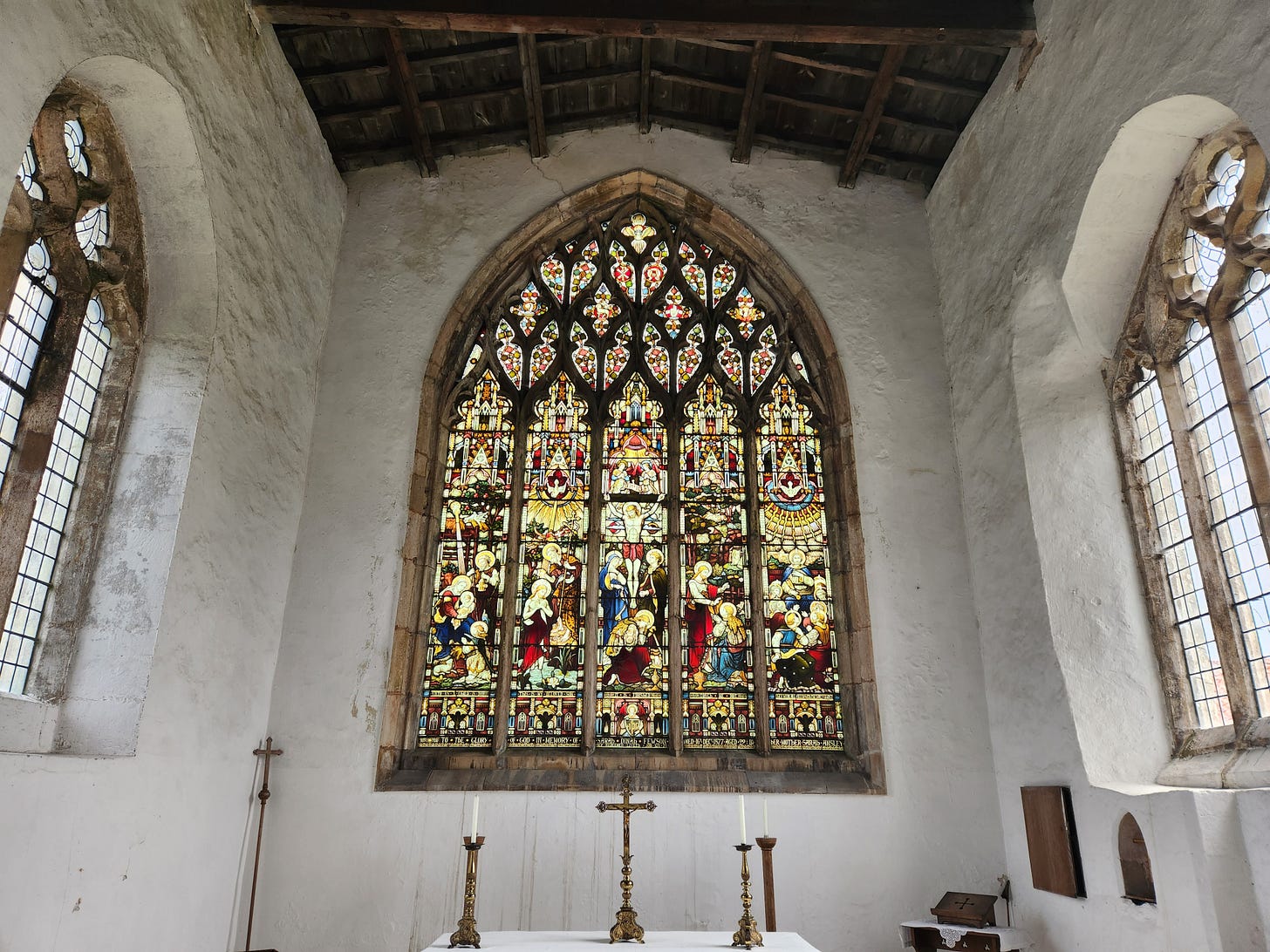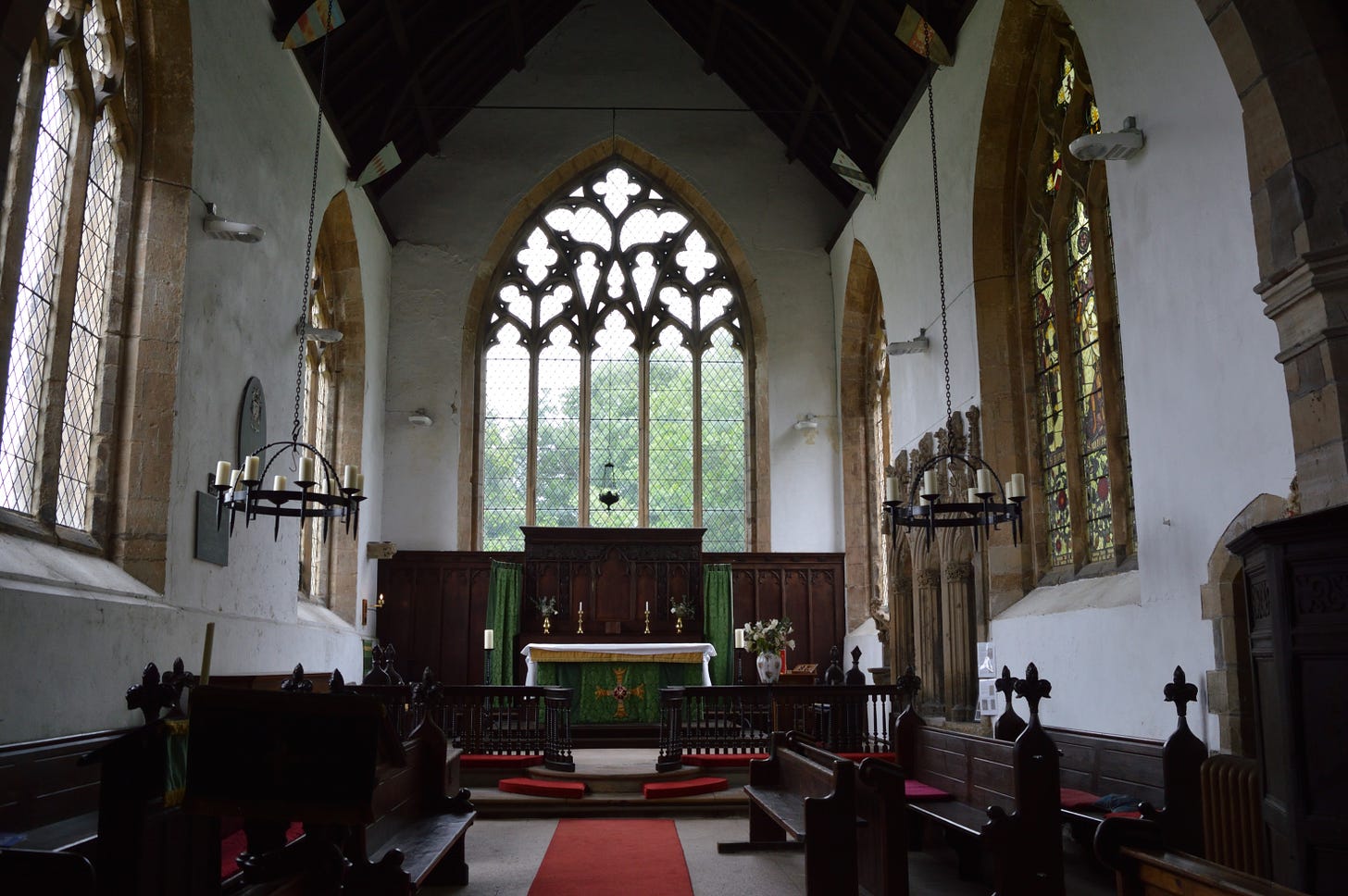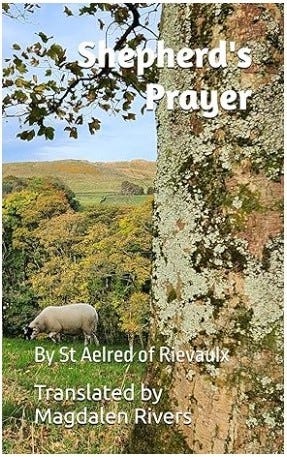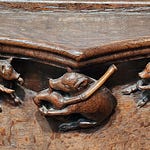The adornment of the chancel, except by such permanent decoration as the carving of wood in screen, stalls, and perhaps reredos, or of stone in arches, niches, and so forth, does not call for much remark. The altar is vested in colours varying according to the sacred seasons of the Christian year, and sometimes hangings of rich colours used to be introduced to add warmth of look to the chancel on special occasions.
A natural mode of expressing joy, still used without criticism in secular rejoicings, is by means of illuminations, and the Church has chosen a similar mode of manifesting her feelings, though here the Puritan finds matter for objection. The great Paschal candle, lighted on Easter Eve and placed near the altar as a symbol of the return of Him who is the Light of the World, and as a token of Easter joy, was often a most magnificent structure. In 1557, three hundred pounds of wax were required for the making of one used at Westminster Abbey. At Durham, the candle stand, besides holding “a great long square taper of wax called the Pascall”, had sconces in the form of flowers of metal for six smaller tapers and had a great deal of carved work and beaten metal to adorn it. Parish accounts often allude to the provision of this great taper, which is kept burning at Vespers and Mass from Easter Eve to the Gospel on Ascension Day. At Reading, for instance, five shillings eight pence was paid in 1559 for “makynge of the Paschall and Funte (font) taper.”
Candlemas, as its name implies, was another occasion for an ecclesiastical illumination. At the procession before the High Mass, a multitude of tapers was carried, but the chancel also received its special adornment by the burning of many lights. There is a curious account of an attempt made by Cosin, subsequently the first Bishop of Durham after the Restoration, to revive this striking usage in the Northern Cathedral. It is contained in a sermon entitled “The Vanity and Downfall of Superstitious Popish Ceremonies preached in the Cathedral Church of Durham, by one Peter Smart, a prebend there, July 27, 1626.” This tale, which Prebendary Smart waxes so wrath over, is to the effect that, “on Candlemas Day last past, Mr. Couzens, in renewing the Popish ceremony of burning candles to the honour of Our Lady, busied himself from two of the clock in the afternoon till four in climbing up long ladders to stick up wax candles in the said Cathedral Church: the number of all the candles burnt that evening was two hundred and twenty, besides sixteen torches, sixty of those burning tapers and torches standing upon and near the high altar, (as he called it), where no man came nigh.”
As to the number and use of the candles upon the altar or altars of the church, the cross or crucifix which stands amid them, and the flowers which so frequently are mingled with them, nothing need here be said: except that there is ample evidence that the modern, revived employment of them has connecting links with their usage in the remote past, in their appearance here and there upon our altars, even in the days of the greatest irreverence, ignorance and neglect.
The ceremonial of creating a Boy Bishop at Childermas and on St Nicholas’ Day has very often been described. We have notices of this custom in all parts of the country, not only in cathedral and collegiate churches but in many simple parish churches.
The office of “Barne Bishop”1 can be traced back as far as 1319 at Salisbury and to 1369 at York. Colet, Dean of St Paul's, found much that was commendable in the usage, and in his Statutes for St Paul's School, issued in 1578, ordained that the scholars should hear the child bishop preaching the cathedral annually. It was required at York, and probably elsewhere, that the lad chosen for this mock dignity should be one who had served well in the minster, who was sufficiently comely, and whose voice was clear and unbroken. The boy chosen was duly invested in all the proper vestments of a bishop, while a number of his companions were suitably robed to attend him as priests and deacons.
The duration of his brief episcopate is variously given. According to some accounts, it commenced on Childermas Eve and terminated at the second Vespers of that festival, so that it lasted only for about twenty-four hours. Elsewhere, however, it is said to have begun on St Nicholas' Day, December 6th, and to have ceased on Childermas Eve, December 27th, so that it lasted in this case for some three weeks. Probably the usage was not uniform throughout the country. During the tenure of the office, the boy bishop performed all the functions of the actual dignitary, holding a kind of visitation, singing vespers and other offices, appointing, so it is alleged at least at Salisbury, to any prebend that fell vacant, and even, incredible as it seems, singing some imitation of the Mass. Wharton says that he performed all the ceremonies, the Mass excepted.
The Computus of Hyde Abbey for 1327, however, contains a disbursement for feasting the boy bishop who had celebrated Mass on St Nicholas' Day, and Henry VIII's proclamation for the abolition of the whole farce distinctly alleges that it was part of the usage for boys to sing Mass and preach in the pulpits. It seems, therefore, certain that so far was the mock ceremonial carried that the child actually sang some sort of dry Mass, for that he was ever suffered to go further than that, it is perfectly impossible to believe.
Coming to the part taken by the choir in the services of the church, we enter upon a subject which is so wide that here it can only be touched upon. Historically, it may be said to stretch in an unbroken line from the organised singers of the Tabernacle down to our time; while the various forms which that organisation has taken, for the better rendering both of the vocal and instrumental music of the sanctuary, provides numerous questions for examination. Nor has controversy been excluded even from a subject so essentially requiring harmony and calculated to promote it as this. At different times and in various places, the lawfulness of the use of music at all has, strange to say, been called into question. The employment of instrumental music was long considered of more than questionable propriety by a large section of the extreme Reformers; and even among ourselves at the present day the rival claims of the ancient and dignified plain-song and of the more varied music of the modern composers are sometimes argued not without a certain amount of heat.
The antiphonal form of chanting, that is, by the division of the choir into two sections which sing alternately in answer one to the other, is unquestionably extremely ancient and was probably derived by the Christian church from the earlier Jewish tradition. In large choirs, as in cathedral and collegiate churches, it was, and indeed still is, usual to divide the choristers into two bodies, sitting respectively on the side of the dean and of the Precentor, and hence called decani and cantoris. A yet more ancient use, however, is said to have been for the whole body of singers, to be placed on one side of the chancel, the officiant occupying the other, and thus versicle and response, antiphon and psalm, was sung alternately by them. Usually, once a week, the side of the choir was changed, so that the higher clergy, who maintained their places, might officiate in due order.
The choir at Beverley Minster
William Thorpe, in his examination before Archbishop Arundel, maintained that “music and minstrelsy that David and other saints of the old law spake of ought now neither to be taken nor used by the letter; but these instruments with their music ought to be interpreted ghostly.”2 With such fanatics there was, of course, no arguing.
In Scotland, as is well known, these sentiments for a long time held sway, and organs are even now barely more than tolerated in some of the Presbyterian Kirks. Even the singing of carols was prohibited by an act of Parliament in the Northern Kingdom, though New Year's Eve is still called Carol Ewyn in Perthshire, from the custom of singing from door to door on that night.
In England, carols of old were extremely popular and were sung in church at Christmastime, a custom that has happily been largely revived of late. These were the vernacular sacred songs or hymns of the people, and were sung not by the choir only, but by the whole congregation.
The use of metrical hymns is very ancient in the Church. Some of the Latin compositions of the kind, having as their authors such early and honoured fathers as St. Hilary of Poitiers, St. Gregory Nazianzen, Paulinus of Nola, Prudentius, and St. Ambrose. The only ancient metrical hymn formally authorised by the English Church since the Reformation is the Veni Creator Spiritus, which forms part of the Ordinal. This fine hymn is first found in the works of Rabanus Maurus, who flourished around 847, and it has been variously assigned to St. Ambrose and Charlemagne.
The consideration of the psalmody of the 17th and 18th centuries here alluded to does not belong to a chapter on the chancel, as at that time the choristers, assisted by a little orchestra of amateur musicians, usually occupied a Western gallery.
With the inauguration of organs almost everywhere, the old parish orchestra has died out. a fact which one cannot regard without some regret. Some effort might surely have been made to blend the new and the old, to preserve the fiddles and bassoons as allies of the organ. The company of minstrels to accompany the music of the divine offices is, in fact, an ancient institution, worthy of preservation from its long tradition, as well as for its own sake. A gallery for its accommodation was often erected. At York and at Chichester there was such a loft above the Reredos. At other places the minstrels were sometimes placed in the Roodloft. The north side of the nave was elsewhere found the most convenient situation, and a gallery, built there for this purpose, exists at Wells and Exeter, and in several foreign cathedrals.
One of the minstrels at Beverley Minster, playing a pipe and hitting a tabor
At St Mary's Beverley is a pillar in the nave, usually called the Minstrels' Pillar, from the fact that the capital is carved with the figures of five musicians playing respectively on the harp, lute, treble and bass flute and tabor, while in Latin the inscription runs beneath, “Pray for the souls of the players.” As a sample of the constitution of the parish orchestra of modern times, it may be mentioned that at Crowle, Lincolnshire, at the date of its supersession by an organ in 1847, the band consisted of two fiddles, a double bass, a flute, a clarionet and a bassoon.
The organ has a venerable antiquity and is mentioned as existing in England as early as the year 700, and in many of our large churches had more than one in different parts of the church. The custom, till lately common, of placing the organ on the rood screen began only at the Restoration,3 when the wholesale destruction of the Puritan era necessitated the rebuilding of instruments in most of the cathedrals. It is now giving way to a method of arrangement, far preferable both from its appearance and its musical effect, by which the organ is divided and placed above the stalls on either side of the chancel. The development and use of this king of musical instruments to be fairly treated would require at least some chapters; we must therefore pass on.
Against the east wall of the church in most cases stands the altar, although in cathedrals a chapel, usually the Lady Chapel, lies eastward of the high altar. In bygone days, however, the altar did not usually stand absolutely against the wall as is now usual, but at the distance of a few feet from it.
The sanctity of the altar is invoked as a cure in some ways. A piece of a candle that has burned on the altar of the parish church of St. Blaise, Cornwall, if applied to a tooth or to the throat, is locally supposed to be an effectual cure for any pain in those members, and diseases in cattle yield to the same remedy.
Sacrament wine, that is wine of the same kind or drawn from the same stock, as that offered in the Holy Eucharist, has also had specially curative properties ascribed to it, but whether this arises from any fancied virtue which it derives from its very remote connection with the Blessed Sacrament, or whether it is only that country clergy have sometimes used a similar wine for the altar, and for giving to the sick poor, it is not very easy to determine. Perhaps both these ideas are combined in the belief.
The practice of making a reverence towards the altar4 on entering and leaving church, a usage stigmatised as superstitious, popish, idolatrous by certain critics of the church, is not only ancient but has been observed continuously in very many parts of England. Its now not uncommon use cannot strictly be called a revival since it has never ceased.
Among the older regulations on the subject we may note one of the statutes of Lincoln Minster, dating from 1440, whereby the vicars, who had been in the habit of running heedlessly and irreverently about the choir, were bidden to bow to the altar at every entrance and egress. Laud, in his revised Statutes of Canterbury, required a similar act of reverence, and it seems to have been observed as an unbroken tradition at St George's Chapel, Windsor, Christchurch, Oxford, and in Durham Cathedral. It is in country parishes and in quiet old world spots that we must look, however, for the most part, for instances of the continuance of this usage. In English villages this practice has in many cases only decayed amid the general carelessness of the present century. Not more than 60 years ago, so it is said, the custom was universal among the Lincolnshire rustics of Kirton-in-Lindsey for the men to pull their forelocks and for the women to curtsy on entering and on leaving the church; and the same is related of many parishes.
Blyborough chancel, with its altar rail directly in front of the altar. It has a curved central door in two parts, 17th century.
Among the modern additions to the furniture of the chancel must be counted the altar rails. Originally, as we have seen in a passage quoted early in this chapter, the laity communicated outside the choir; the altar therefore needed no protection beyond the chancel screen. When, however, the Reformers pulled down these screens, and the Puritans began to drag the altars into the midst of the chancel,5 or of the church, placing them table-wise, it became necessary to provide some new form of protection. In the time of Bishop Andrews, therefore, the use of altar rails began, that saintly prelate referring to them under the name of “Wainscot Banisters.” They did not, however, become general until the days of Laud, who insisted upon the altars being replaced altar-wise and being fenced about to prevent their being irreverently used. As the employment of this railing was a visible assertion of the sanctity of the altar and of its mysteries, the Puritans detested it; and the journal of William Dowsing, the Parliamentary Visitor of Churches during the Great Rebellion, shows that he had it pulled down wherever met with. In some churches at the time of the offering of the Holy Eucharist, this rail is covered with a linen cloth, a relic or revival of the houseling cloth, which communicants held beneath the chin to catch any fragment of the Blessed Sacrament which might fall. Among churches where this ancient custom still prevails are St. German’s, Wimborne, Leamington Priory, and Hensall in Yorkshire.
Next Extract
Have you seen my new publication - Shepherd’s Prayer? Available now via Amazon around the world, the isbn is: 979-8344184814.
I think the word “barne” is the same as “bairn”, which means child.
The word “ghostly” in the late medieval period generally meant “spiritually”.
The “Restoration” refers to the restoration of the monarchy, with King Charles II in 1660, after the Commonwealth (Republican and Puritan) period of English history.
In this case the author means bowing to the altar. Most Catholics don’t distinguish between the Blessed Sacrament and the altar but the strict rule is you genuflect to the Blessed Sacrament and bow to an altar. If Mass is being celebrated at a side altar, the celebrant and acolytes genuflect to the Blessed Sacrament as they pass, but then bow to the altar on approaching it. I recently witnessed two young altar boys being very confused by this, but I’ve also seen a deacon forget too!
It is somewhat ironic that what the Reformation failed to force the Catholic church to do, was quietly surrendered after Vatican II without fuss.

















Share this post